Abstract
The attachment of eastern equine encephalitis virus to chicken embryo fibroblasts was studied at 0 degrees C. The binding specifically responsible for initiating infection was studied in the initial experiments by employing plaque-forming ability as the measured response. Results from these initial studies were closely paralleled in studies of binding of radiolabeled virus under the same conditions. Binding that had occurred at the pH optimum, pH 6.5, could be reversed only at higher pH. The observed pH dependence of virus attachment suggested the interaction of at least two ionizable species in the initial binding of virus to cell, and that one to three attachments must occur between virus and cell prior to infection.
Full text
PDF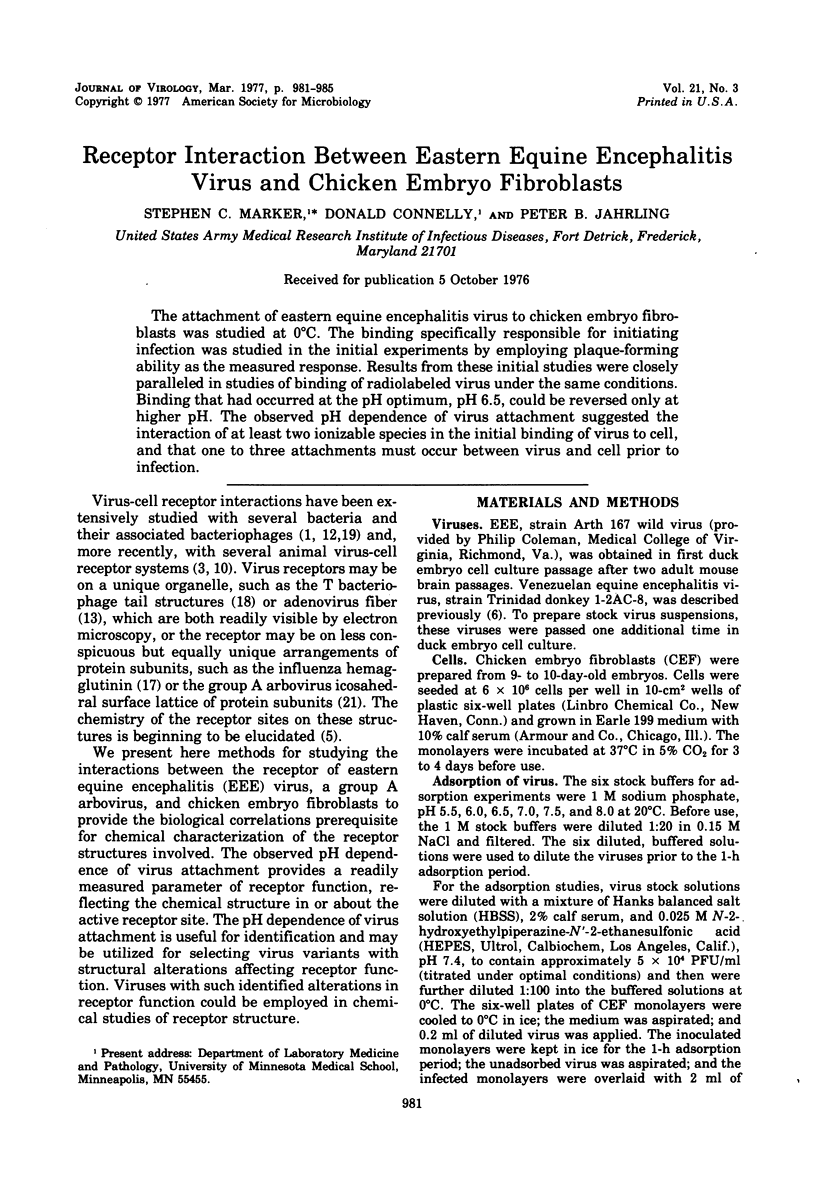
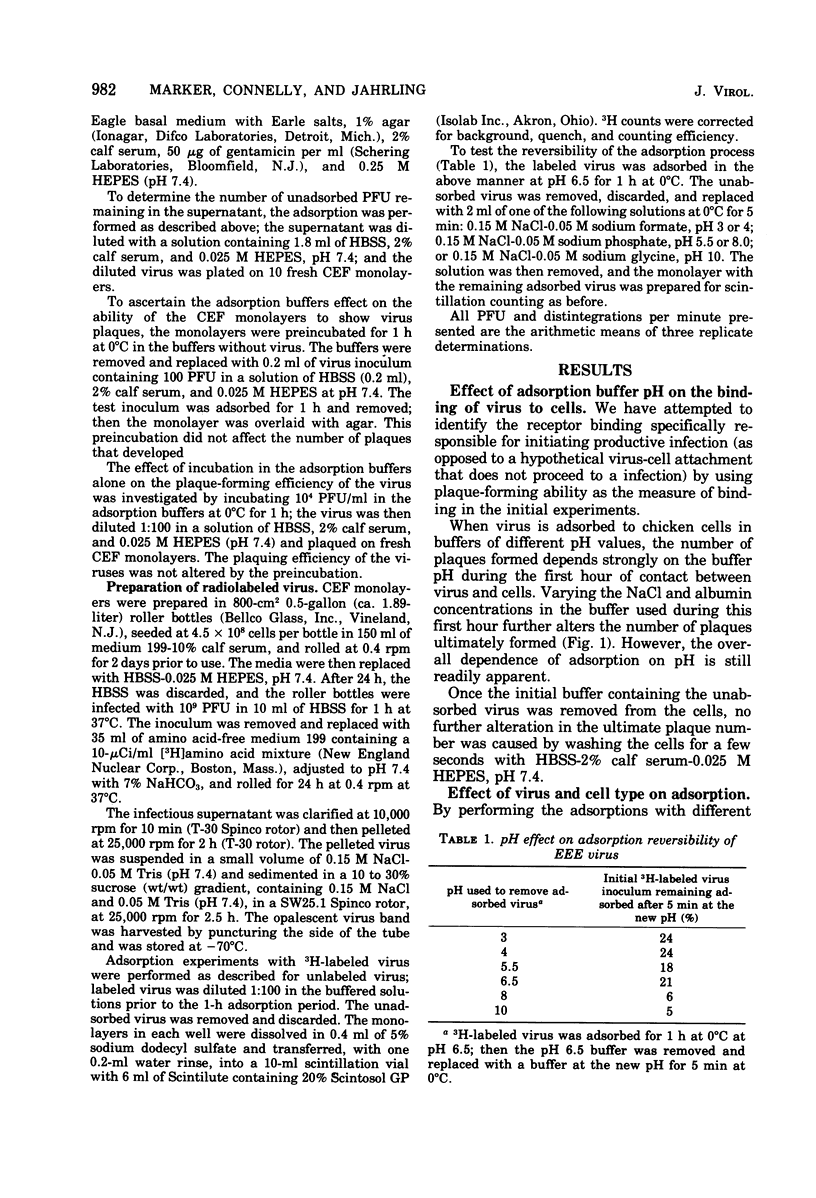
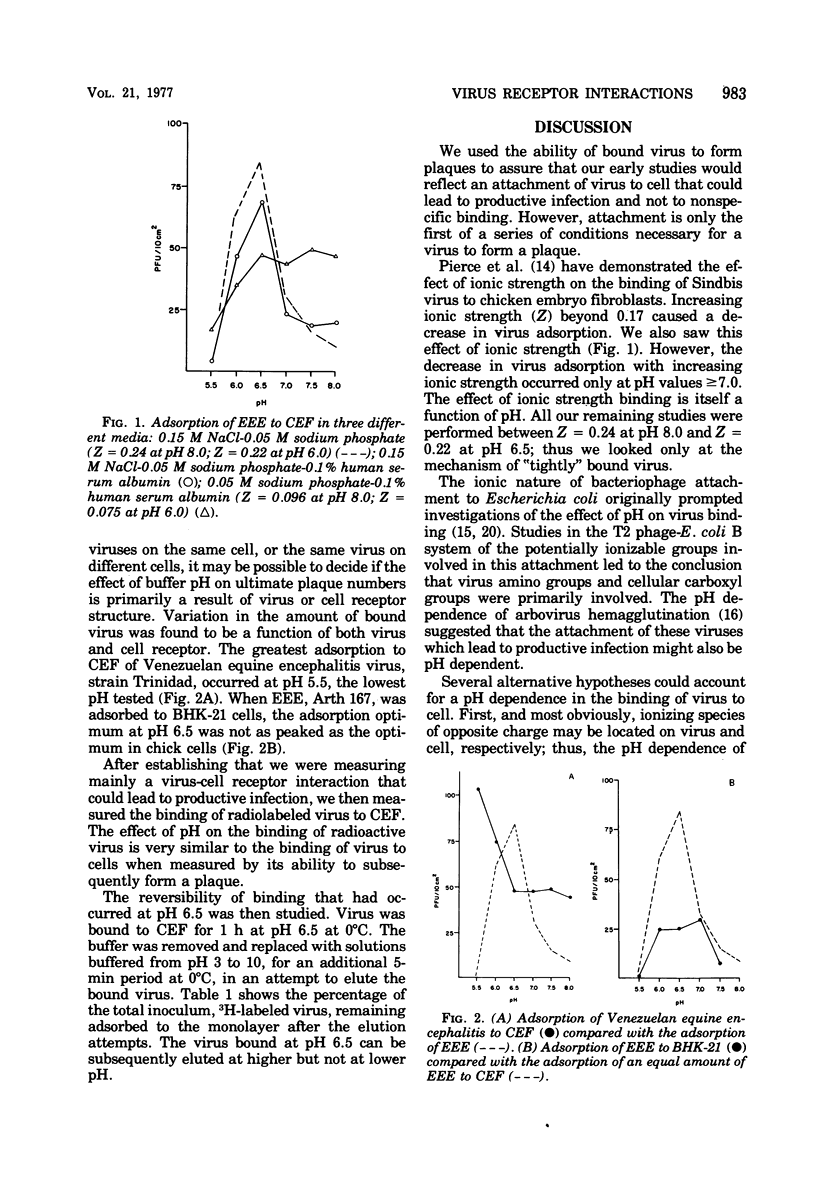
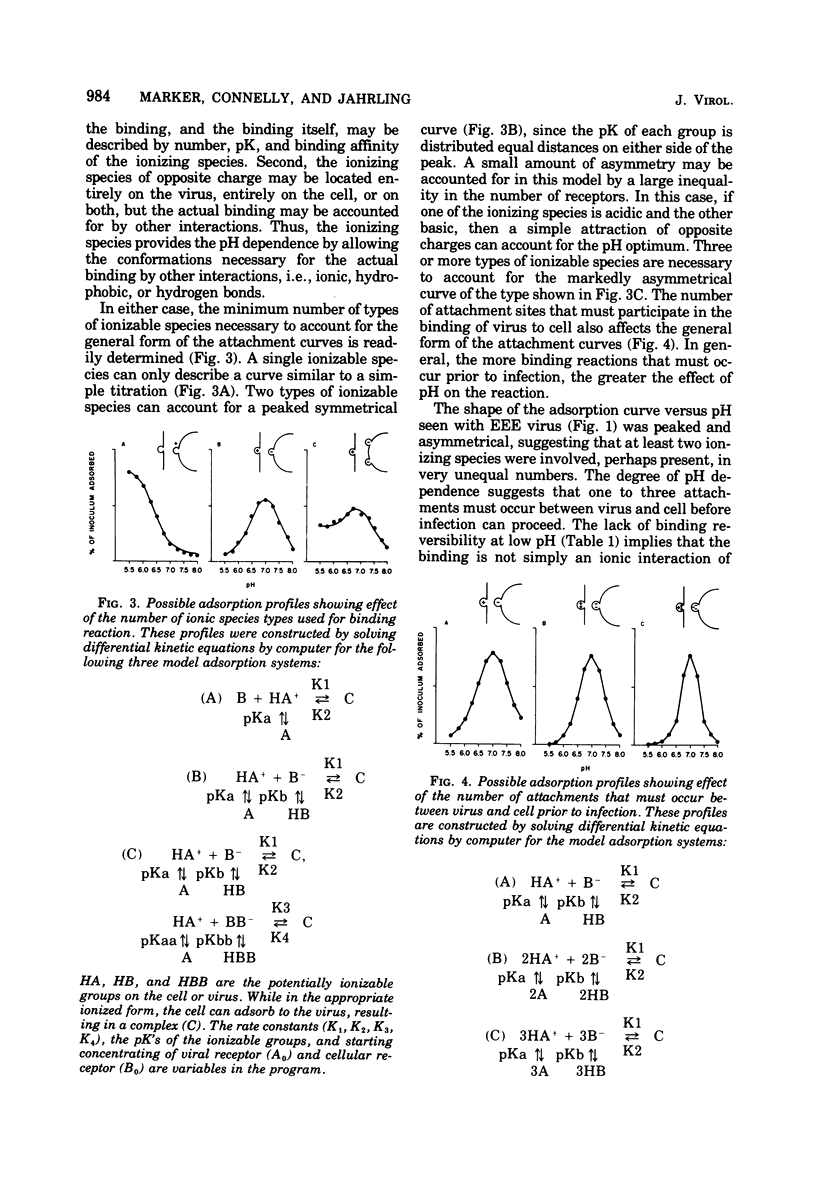
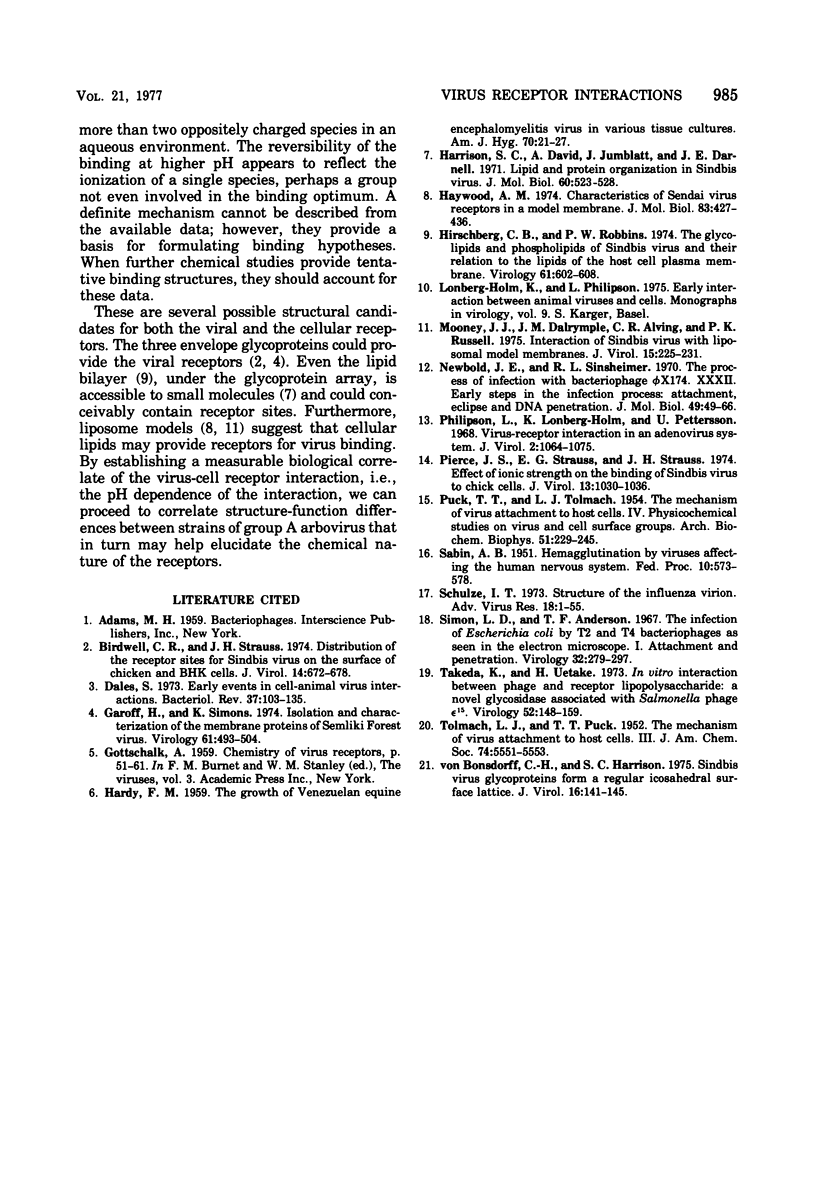
Selected References
These references are in PubMed. This may not be the complete list of references from this article.
- Birdwell C. R., Strauss J. H. Distribution of the receptor sites for Sindbis virus on the surface of chicken and BHK cells. J Virol. 1974 Sep;14(3):672–678. doi: 10.1128/jvi.14.3.672-678.1974. [DOI] [PMC free article] [PubMed] [Google Scholar]
- Dales S. Early events in cell-animal virus interactions. Bacteriol Rev. 1973 Jun;37(2):103–135. doi: 10.1128/br.37.2.103-135.1973. [DOI] [PMC free article] [PubMed] [Google Scholar]
- Garoff H., Simons K., Renkonen O. Isolation and characterization of the membrane proteins of Semliki Forest virus. Virology. 1974 Oct;61(2):493–504. doi: 10.1016/0042-6822(74)90285-2. [DOI] [PubMed] [Google Scholar]
- HARDY F. M. The growth of Venezuelan equine encephalomyelitis virus in various tissue cultures. Am J Hyg. 1959 Jul;70(1):21–27. doi: 10.1093/oxfordjournals.aje.a120061. [DOI] [PubMed] [Google Scholar]
- Haywood A. M. Characteristics of Sendai virus receptors in a model membrane. J Mol Biol. 1974 Mar 15;83(4):427–436. doi: 10.1016/0022-2836(74)90504-x. [DOI] [PubMed] [Google Scholar]
- Hirschberg C. B., Robbins P. W. The glycolipids and phospholipids of Sindbis virus and their relation to the lipids of the host cell plasma membrane. Virology. 1974 Oct;61(2):602–608. doi: 10.1016/0042-6822(74)90295-5. [DOI] [PubMed] [Google Scholar]
- Mooney J. J., Dalrymple J. M., Alving C. R., Russell P. K. Interaction of Sindbis virus with liposomal model membranes. J Virol. 1975 Feb;15(2):225–231. doi: 10.1128/jvi.15.2.225-231.1975. [DOI] [PMC free article] [PubMed] [Google Scholar]
- Newbold J. E., Sinsheimer R. L. The process of infection with bacteriophage phiX174. XXXII. Early steps in the infection process: attachment, eclipse and DNA penetration. J Mol Biol. 1970 Apr 14;49(1):49–66. doi: 10.1016/0022-2836(70)90375-x. [DOI] [PubMed] [Google Scholar]
- PUCK T. T., TOLMACH L. J. The mechanism of virus attachment to host cells. IV. Physicochemical studies on virus and cell surface groups. Arch Biochem Biophys. 1954 Jul;51(1):229–245. doi: 10.1016/0003-9861(54)90470-1. [DOI] [PubMed] [Google Scholar]
- Philipson L., Lonberg-Holm K., Pettersson U. Virus-receptor interaction in an adenovirus system. J Virol. 1968 Oct;2(10):1064–1075. doi: 10.1128/jvi.2.10.1064-1075.1968. [DOI] [PMC free article] [PubMed] [Google Scholar]
- Pierce J. S., Strauss E. G., Strauss J. H. Effect of ionic strength on the binding of Sindbis virus to chick cells. J Virol. 1974 May;13(5):1030–1036. doi: 10.1128/jvi.13.5.1030-1036.1974. [DOI] [PMC free article] [PubMed] [Google Scholar]
- SABIN A. B. Hemagglutination by viruses affecting the human nervous system. Fed Proc. 1951 Jun;10(2):573–578. [PubMed] [Google Scholar]
- Simon L. D., Anderson T. F. The infection of Escherichia coli by T2 and T4 bacteriophages as seen in the electron microscope. I. Attachment and penetration. Virology. 1967 Jun;32(2):279–297. doi: 10.1016/0042-6822(67)90277-2. [DOI] [PubMed] [Google Scholar]
- von Bonsdorff C. H., Harrison S. C. Sindbis virus glycoproteins form a regular icosahedral surface lattice. J Virol. 1975 Jul;16(1):141–145. doi: 10.1128/jvi.16.1.141-145.1975. [DOI] [PMC free article] [PubMed] [Google Scholar]


